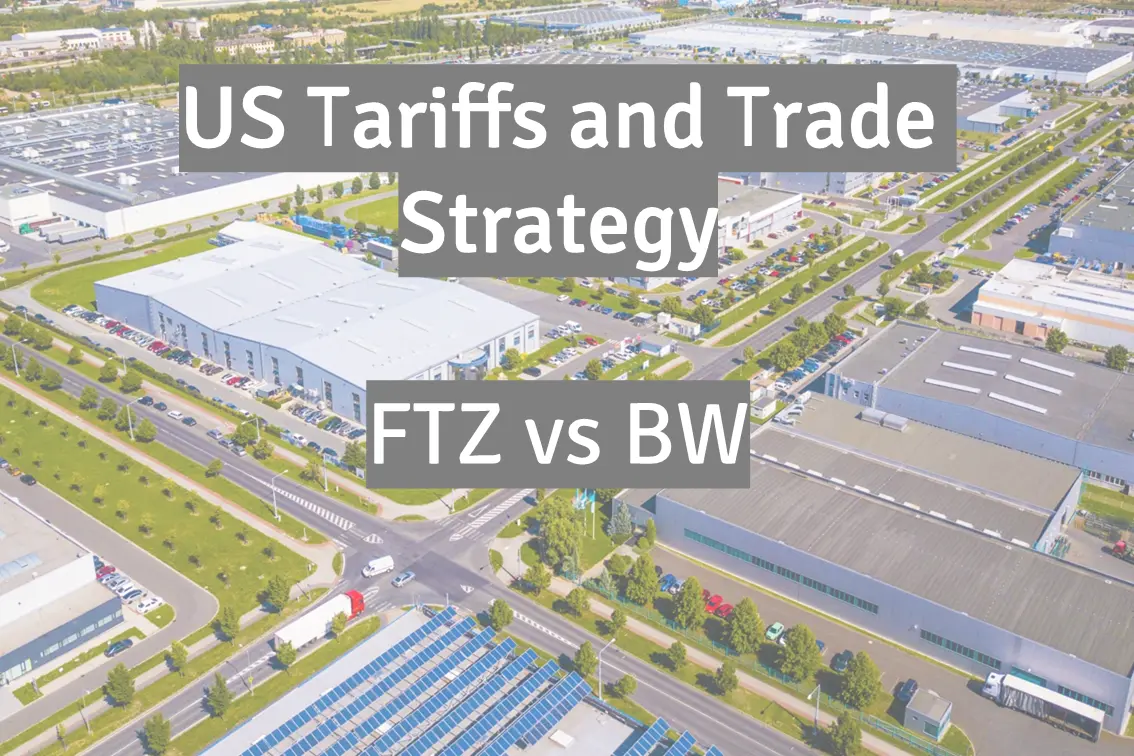Unlocking Duty Mitigation: Comparing the Benefits of Bonded Warehouses and Foreign Trade Zones

Bonded Warehouses and Foreign Trade Zones (FTZs) have become pillars of strategic tariff mitigation for importers facing heightened duties in today’s fast-evolving trade climate. As U.S. customs enforcement intensifies and supply chains grow increasingly complex, the value proposition of both these mechanisms has only risen. Understanding how each works, their respective benefits, and the contexts in which one may outpace the other is essential for businesses grappling with the implications of recent and ongoing duty increases.
Navigating U.S. Duty Increases with Strategic Warehousing
Bonded Warehouses and Foreign Trade Zones (FTZs) have become pillars of strategic tariff mitigation for importers facing heightened duties in today’s fast-evolving trade climate. As U.S. customs enforcement intensifies and supply chains grow increasingly complex, the value proposition of both these mechanisms has only risen. Understanding how each works, their respective benefits, and the contexts in which one may outpace the other is essential for businesses grappling with the implications of recent and ongoing duty increases.
What are Bonded Warehouses and FTZs?
A bonded warehouse is a secure customs-controlled facility authorized for the storage of imported goods awaiting clearance, often for up to five years. Goods inside are considered ‘not yet entered’ into U.S. commerce for tariff purposes. Duties and taxes are not paid until, and unless, the goods are withdrawn for consumption in the domestic market. This allows importers considerable flexibility to manage cash flow and defer payments on inventories that might be destined for re-export or eventual domestic sale.
Conversely, Foreign Trade Zones represent designated sites under U.S. jurisdiction, often located near ports or industrial hubs, where imported goods can be held, manipulated, manufactured, or assembled under specific customs oversight. In FTZs, duties are only assessed when finished products exit the zone for U.S. consumption—not on the imported components themselves if they are re-exported, transformed, or consumed within the zone.
Financial Advantages: Deferred Duties and Inverted Tariff Savings
From a financial perspective, both solutions offer deferred duty payments, but FTZs introduce the added benefit of inverted tariff savings. This means for certain goods or industries, the duty rate on the finished product can be lower than that on its individual imported components. Manufacturers within an FTZ can thus source parts from abroad, assemble or transform them in the zone, and—in cases where finished good duties are lower—pay the reduced rate at the time of U.S. entry. Bonded warehouses, meanwhile, do not modify tariff classification or rates. They are purely a mechanism for suspension and eventual payment or cancellation (if the goods are exported).
Operational Flexibility and Inventory Control
Inventory control and operational flexibility mark another axis of differentiation. Bonded warehouses are ideal for importers needing secure long-term storage for sensitive, seasonal, or regulated goods. The model is straightforward: goods enter, are stored, and leave either for U.S. consumption (with duty payment) or for export without ever having incurred U.S. taxes or duties. This makes them especially popular in industries like luxury goods, pharmaceuticals, and perishables with uncertain or fluctuating demand patterns. The loss-prevention environment of bonded storage—tight customs monitoring, restricted access, and high accountability—can reduce shrinkage and unauthorized movement, further strengthening value for import-sensitive sectors.
FTZs, in contrast, are built for more dynamic operations. They allow not just storage but manipulation, repair, mixing, repackaging, and full-scale manufacturing under customs supervision. This permits businesses to delay duty assessment on goods while adding value, shifting components between products, or altering the physical and tariff status of merchandise. For companies with domestic production ambitions or those assembling multi-origin components into finished goods for diverse markets, FTZs provide the agility to respond rapidly to demand with regulatory support. Additionally, waste, scrap, and defects generated within an FTZ are not subject to duties—an appealing feature for manufacturers with significant production loss.
Compliance Considerations and Accessibility
On the compliance front, both require rigorous documentation, but FTZs usually demand higher investment in regulatory infrastructure. Establishing an FTZ can entail considerable initial setup, necessitate robust compliance protocols, staff training, and ongoing reporting to U.S. Customs and Border Protection. Bonded warehouses, while also strictly regulated and regularly audited, present a less complex onboarding process. Small and mid-sized firms with intermittent import flows may find bonded facilities easier to adopt, whereas FTZs are suited to organizations equipped for continuous import, processing, and manufacturing activity.
Duty Drawback and Export Incentives
Duty drawback and export programs underscore another important comparative feature. Goods stored in bonded warehouses and FTZs are both eligible for duty drawback—a refund mechanism for duties paid on goods eventually exported. In either scenario, importers can store, process, and export inventory without incurring permanent duty liabilities. Yet, FTZs extend this advantage by permitting businesses to bring in foreign merchandise, transform it, and ship to foreign markets without paying duties at any stage. Bonded warehouses are limited to refunding duties on goods that remain unentered and are exported as is; significant transformation occurs outside bonded facilities.
Resilience in Modern Supply Chains
In terms of supply chain resilience, both solutions have proved invaluable amid heightened Section 301 tariffs and volatile global trade. By keeping inventory off the books for duty payment until market clarity emerges, importers can respond nimbly to new trade policies, consumer trends, and economic shocks. The flexibility to hold goods, reroute them, or even cancel import plans became critical tools in managing risk while maintaining operational continuity.
Geography and Collaboration
Geographic access and partnership opportunities add a further layer to the discussion. FTZs tend to be concentrated around major port cities, industrial parks, and transportation corridors, creating hubs for multi-modal logistics and access to skilled labor. Businesses operating within an FTZ can collaborate with supply chain partners, logistics firms, and manufacturers under one regulatory umbrella, streamlining imports, exports, and domestic distribution from a single site. Bonded warehouses may be more widely dispersed and regionally approachable, providing solutions even in areas where FTZ designation is unavailable or impractical.
Tax Savings Beyond Duty Deferral
Tax and fee mitigation emerge as additional advantages of FTZ usage. Products stored or processed in an FTZ are exempt from state and local inventory taxes—a cost that can add significant burden for companies with large or slow-moving inventory. Bonded warehouses don’t convey this exemption, focusing instead on federal duty and tax deferral. For enterprises with substantial warehousing needs, FTZ sites render the double benefit of cash flow improvement and reduction in inventory-related tax outlays.
Digital Integration and Process Automation
Digital integration and automation have brought further enhancements to both environments, enabling sophisticated tracking, customs reporting, and supply chain analytics. FTZs, however, often lead in adopting advanced software for security, compliance, and inventory management, harnessing the scale and complexity of their operations. Bonded warehouses, geared toward simpler storage and movement, likewise benefit from improved traceability, but the regulatory requirements are less demanding compared to the FTZ ecosystem.
Which Option Fits Your Business Needs?
When choosing between a bonded warehouse and an FTZ, several factors come into play: the nature of the goods, the intended operations (storage versus transformation), the volume and regularity of imports, the likelihood of re-export, the proximity to major logistics hubs, and the company’s capacity for compliance management. Bonded warehouses offer a fit-for-purpose solution for entities needing reliable, secure, long-term storage of goods pending re-export or liquidation, with straightforward duty deferral and minimal administrative overhead. FTZs, by contrast, suit importers and manufacturers who seek to create, assemble, or manipulate goods at scale while deferring or minimizing duties, taxes, and fees on both components and finished products.
Regulatory Trends and Strategic Hybrid Solutions
It is also important to consider the regulatory environment. Recent U.S. customs enforcement trends, including the tightening of Section 301 tariff controls, have elevated scrutiny of all tariff mitigation mechanisms. FTZ operators must maintain robust compliance programs, ready for frequent audits and reporting, given the complexity and volume of in-zone manufacturing, processing, and distribution. Bonded warehouses, while also subject to inspection, usually carry less regulatory risk due to the static nature of stored goods and simpler documentation requirements for entry and release.
In the broader strategic context, the decision between bonded warehousing and FTZ integration is rarely binary: many large-scale importers combine both. A business might utilize bonded warehouses for seasonal goods awaiting market signals and FTZs for ongoing production and assembly, tailoring solutions across product lines and supply chain touchpoints. This hybrid approach maximizes tariff optimization, compliance flexibility, and market responsiveness, dovetailing regulatory requirements with commercial goals.
Conclusion: Empowering Resilience and Foresight in Duty Management
Ultimately, both bonded warehouses and Foreign Trade Zones supply importers with vital, customizable options for navigating the intricacies of U.S. customs, tariffs, and evolving trade policy. Bonded warehouses, with their simplicity, long-term storage benefits, and duty deferral, are ideally suited for companies that prioritize cash flow management and minimal administrative burden. FTZs, with their expansive capabilities for manipulation, assembly, duty inversion, and tax relief, fit organizations committed to higher levels of operational integration and supply chain complexity.
By adapting these solutions to their specific needs, importers are better equipped to withstand the disruptions of tariff increases, geopolitical shifts, and enforcement surges. Both FTZs and bonded warehouses reflect an evolution in trade strategy, enabling companies to reclaim control over duty payments, inventory management, and market timing. Whether used independently or in concert, they empower businesses to chart a clear course through the ever-changing horizons of international commerce, meeting the challenges of today’s tariff landscape with resilience and foresight.
Are you impacted by the new US tariff levels? Contact Trade Duty Refund to learn how to mitigate the cost of importing to the US in full compliancy.
